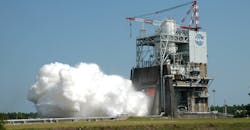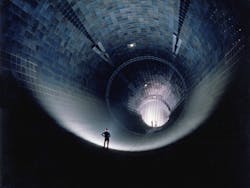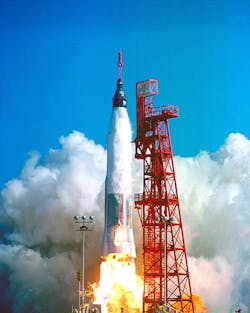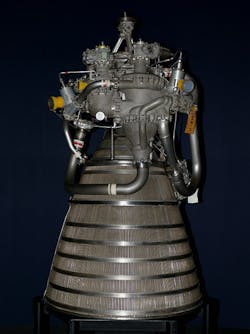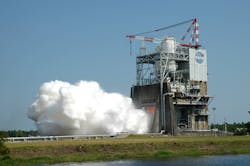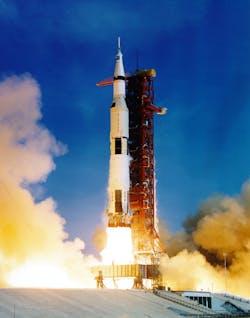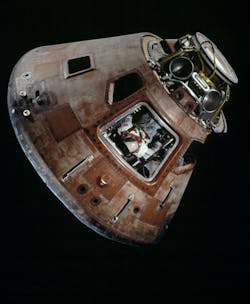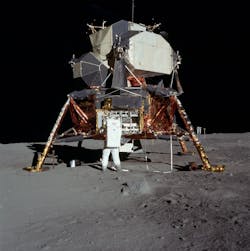8 of ASME’s Space Age Milestones in Mechanical Engineering
Mechanical engineers played a pivotal role in the Space Race, designing engines, structures, and components, as well as test facilities that helped propel the U.S. into space and to the Moon and beyond. Here’s a look at some of them.
Propulsion Wind Tunnel at Arnold AFB (1955)
The wind tunnel at Arnold Air Force base was the first large-scale facility for testing jet and rocket engines in simulated high-speed flight conditions. It ended up combining transonic (1955) and supersonic (1960) tunnels with both using a common 236,000 hp drive, the world’s largest when it was built. It can replicate air speeds of Mach 4.75 at altitudes up to 150,000 ft in its 16 ft2 test sections. The tunnels were designed to test full-scale engines, large aircraft models, or large and full-scale missiles. It has contributed to nearly every major U.S. military aircraft and it hardware. That included the Titan ICBM, Mercury program escape tower, SRAM-A missile, MCX ICBM models, and the NASA shuttle orbiter.
Atlas Launch Vehicle (1957)
America’s first launcher was the Atlas E-2 Space Booster, a modified ICBM developed by engineers at the Convair Div. of General Dynamics and the U.S. Air Force. The first of its more than 500 flights was in June of 1957. After that, it was responsible for launching the Pioneer, Ranger, Mariner, and Surveyor, as well as the first communication satellite. Many payloads were sent into orbit as detachable sections of the Atlas. And in 1962, John Glenn road atop an Atlas to become the first American to orbit the Earth.
RL-10 Rocket Engine (1958)
The RL-10, the first rocket engine to use high-energy liquid hydrogen as fuel, began development at Pratt & Whitney in the fall of 1958. By November of 1963, a pair of them boosted a Centaur space vehicle into orbit. Two months later, a cluster of six RL-10 took part in the first test flight of the Saturn S-IV stage. The engine generates 15,000 lb. of thrust and has the highest specific impulse of any operational rocket engine. Among the innovations it pioneered was the bootstrap cycle, in which the fuel was used for several purposes before being burned. In the RL10, icy cold hydrogen circulated around the thrust chamber, cooling it and preventing the 5,000°F temperatures inside from damaging anything. Then it was expanded through a turbine into a high-pressure gas to power the fuel pumps and drive engine accessories. The engine can also be restarted several times in space (seven times in one mission), and be throttled to less than 10% of rated thrust. It was used on more than 140 flights to take satellites and payloads into orbit. It never failed.
Advanced Engine Test Facility (1964)
NASA’s Advanced Engine Test Stand was designed by ex-Nazi Werner von Braun to do testing on the Saturn V rocket’s booster engine, but it has since been used for a host of other rocket engines, including those used on the space shuttle. The 400-ft structure stands on four partially hollow concrete legs, each four-feet thick and 144-ft tall. These legs required 12 million lb. of concrete to construct. There are instruments inside the legs that monitor 850 engine parameters during firing. The structure includes a 200-ton crane and boom sitting 144 ft up. The test stand can withstand 12 million pound of thrust, and a 1,900-ton flame deflector keeps the structure and surroundings safe. The deflector has more than 387,000 holes, each 5/32 of an inch in diameter, and during tests, 237,000 gallons of water were pushed through these holes to keep the deflector cool. The water is pumped by 13 diesel engines, each using its 2,577 hp to pump 21,000 gallons per minute.
Saturn V Rocker (1967)
The Saturn V was the first purpose-built rocket, and its purpose was to carry the 45-ton Apollo spacecraft to the moon and back (which it did—several times). It also put the 120-ton Spacelab into orbit. The three-stage rocket stood 363 ft tall and weighed about 6.1 million lb. when loaded. It carried out 13 missions between 1967 and 1972, and the Saturn program racked up charges of about $7 billion. Three unused Saturn Vs are on display at NASA centers in Florida, Alabama, and Texas.
Apollo Space Command Module (1968)
The Command Module, built by North American Aviation, was the section of the Apollo spacecraft in which three astronauts lived and operated the missions that took them from Earth to the moon orbit and back. It is the only part of the entire spacecraft that came back to Earth in one piece. This means it was the only part of the ship that needed to survive the wicked heat of the re-entry to Earth’s atmosphere at 25,000 mph. The crew had 210 ft3 that was kept at 70 to 75°F and a pure oxygen atmosphere pressurized to 5 psi. The oxygen proved a problem on Apollo 1 while it was being tested on the ground prior to launch. A fire got started, and the three astronauts—Virgil “Gus” Grissom, Edward White, and Roger Chaffee—were killed. The module was redesigned for future flights, though it still used pure oxygen in space.
Apollo Lunar Module LM-13 (1968)
Like the last two ASME milestones, this one—the Lunar Module (aka Eagle)—was critical in putting a person on the moon. Built by Grumman Aircraft Engineering Corp., it carried two astronauts from lunar orbit down to the moon, and then a portion of it launched from the moon to rendezvous and dock with the command module. It served as shelter and base for two astronauts as they explored the moon and carried a variable-thrust engine for descent and a fixed-thrust engine for launch. Engineers wrestled with constant compromises between weight, available space, and performance requirements while designing the lunar module. For example, to save space and weight, there were no seats. The astronauts could access the controls, see out the windows, and navigate while standing up. The gravitational loads were minimal, so they could also sleep while standing, if necessary.
Voyager I and 2 Spacecraft (1977)
Voyagers 1 and 2 are identical spacecraft designed for five-year missions to explore Jupiter and Saturn, and both launched in the late summer of 1977. (In the illustration above, Voyager 1 is on the left and Voyager 2 on the right.) Each 1,825-lb. spacecraft carries three thermoelectric generators powered by the radioactive decay of plutonium. They also each have three computers and an array of sensors (detecting visual, IR, UV, plasma, cosmic rays, charged-particles, and magnetic fields signals). After their missions were over, engineers and scientists kept working on them; they have continued to operate and send back valuable data ever since—for almost 40 years now. Both are now leaving the solar system, having already explored Jupiter, Saturn and its rings, Uranus, Neptune, and the 48 moons of these planets.
